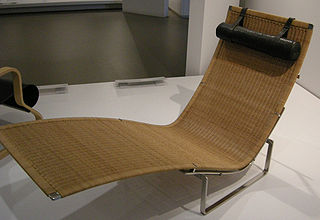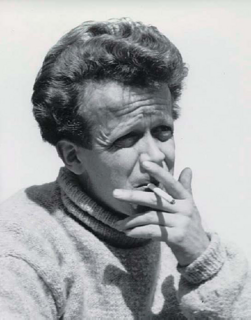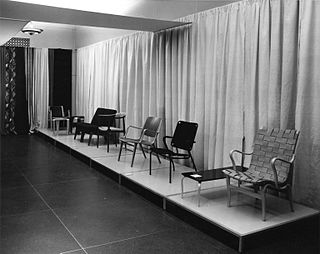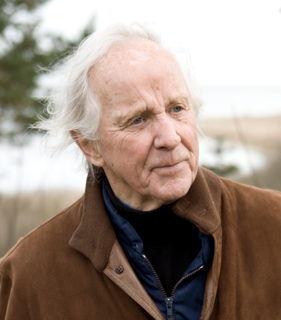
Poul Kjærholm was a Danish designer.

Hans Jørgensen Wegner was a world-renowned iconic Danish furniture designer. His high quality and thoughtful work, along with a concerted effort from several of his manufacturers, contributed to the international popularity of mid-century Danish design. His style is often described as Organic Functionality, a modernist school with emphasis on functionality. This school of thought arose primarily in Scandinavian countries with contributions by Poul Henningsen, Alvar Aalto, and Arne Jacobsen. In his lifetime he designed over 500 different chairs, over 100 of which were put into mass production and many of which have become recognizable design icons.

California College of the Arts (CCA) is an art, design, architecture, and writing school with two campuses in California, one in San Francisco and one in Oakland. Founded in 1907, it enrolls approximately 1,500 undergraduates and 500 graduate students.

Kristian Solmer Vedel was a Danish industrial designer and part of the Scandinavian Design movement.

Scandinavian design is a design movement characterized by simplicity, minimalism and functionality that emerged in the early 20th century, and which flourished in the 1950s, in the five Nordic countries of Denmark, Finland, Iceland, Norway, and Sweden.
Nanna Ditzel was a Danish furniture designer.

John Axel Prip (1922–2009), also known as Jack Prip, was a master metalsmith known for setting standards of excellence in American metalsmithing. His works and designs have become famous for bringing together the formal, technical tradition of Danish design into harmony with the American desire for innovation. Several of his designs for the Reed and Barton Company are still in production today.

Danish modern is a style of minimalist furniture and housewares from Denmark associated with the Danish design movement. In the 1920s, Kaare Klint embraced the principles of Bauhaus modernism in furniture design, creating clean, pure lines based on an understanding of classical furniture craftsmanship coupled with careful research into materials, proportions and the requirements of the human body. With designers such as Arne Jacobsen and Hans Wegner and associated cabinetmakers, Danish furniture thrived from the 1940s through the 1960s. Adopting mass-production techniques and concentrating on form rather than just function, Finn Juhl contributed to the style's success. Danish housewares adopting a similar minimalist design such as cutlery and trays of teak and stainless steel and dinnerware such as those produced in Denmark for Dansk in its early years, expanded the Danish modern aesthetic beyond furniture.
Komplot Design is a design studio based in Copenhagen, Denmark. It was founded in 1987 by Danish architect Poul Christiansen and Russian-born designer Boris Berlin. The company works within the fields of industrial, graphic and furniture design.
Cecilie Manz is a Danish industrial designer. She is considered one of the leading Danish furniture designers of her generation. In November 2017 she was awarded Designer of the year in the Design Awards by Bo bedre, Costume Living, Nordic Living and Boligmagasiet. In September 2014, she won the Danish Crown Prince Couple's Culture Award for her contribution to design. Cecilie Manz extends the understanding of the function and aesthetics of design and challenges the established concepts of industrial design.
Kasper Salto is a Danish industrial designer, most known for his furniture designs. He is the grand son of painter, ceramist and writer Axel Salto.

Børge Mogensen, was a Danish furniture designer.
Mogens Koch was a Danish architect and furniture designer and, from 1950 to 1968, a professor at the Royal Danish Academy of Fine Arts. He was married to the weaver Ea Koch.

Jacob Jensen, was a Danish industrial designer best known for his work with Bang & Olufsen. Jensen designed numerous popular high-end consumer products, developing a functional minimalism style that formed a prominent part of the Danish modern movement. In 1958 he founded the Jacob Jensen Design Studio. Jensen designed for other brands including Alcatel, Kirk, Boform, General Electric, International Gift Corporation, JO-JO, Labofa, Rodenstock, Rosti, and Stentofon. His works have been featured at the Museum of Modern Art (MoMA) in New York City, and have received numerous design awards.
Jørgen Gammelgaard (1938–1991) was a Danish furniture designer who also designed lamps and silverware.
Professor.Arkitekt. Jørgen Kastholm. IDD/BDA (1931–2007)

Erik Jørgensen is a Danish furniture company. It has its own design team and also works with external designers.
Lorenzen is a surname. It is a patronymic from the name Lorenz. It is of North German, Dutch, Danish, and Norwegian origin.
Franziska Paula Konstante Rasmussen née Duden (1907–1994) was a German-born textile artist and painter who moved to Denmark in 1930. Initially influenced by the minimalist Bauhaus style, she soon developed her own distinctive Structuralist approach to weaving, becoming one of Denmark's most important contributors to tapestry. In 1935, she joined the Danish School of Arts and Crafts (Kunsthåndværkerskole) where she remained for over 40 years, teaching painting and composition, increasingly with an emphasis on textile art.













